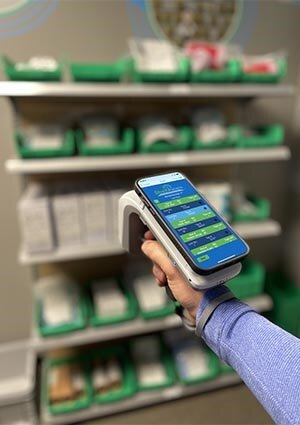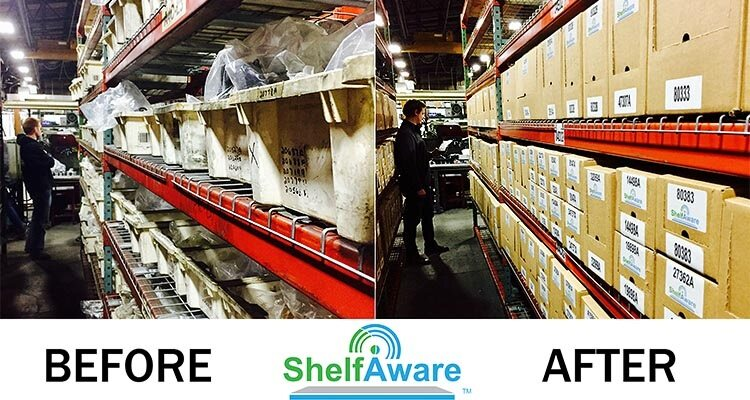How seemingly simple automation can solve inventory management challenges
Inventory is a necessary evil for most of us involved with the supply chain space. Suppliers and their consumers are often caught playing a game of hot potatoes with this dreaded asset. No one wants to hold the inventory, but everyone knows there must be some in the supply chain to avoid the dreaded stock-out or worse, a plant shutdown. Shutting down a large operation because you have stocked out of a five-cent part is the cardinal sin of any supply chain manager.
Industry pundits have been chanting, ‘go digital!’ for years. However, very few have offered practical solutions for inventory management and most industry players

are still tracking with clip boards, barcode scanners, or just their eyeballs. It would make sense to assume that the top ten largest industrial distributors have it figured out. They all talk a big innovation game, posting huge investments in the technology space at every investor meeting; but most of them still use extensive networks of branch locations, holding localized inventory and an army of employees to solve this problem.
Weary of the constant battle of low inventory turns versus customer satisfaction, innovators from a small Midwest distribution company realized that it was not realistic to compete with the big guys using a manual VMI (vendor managed inventory) system. As a more practical solution, they provided a digital platform with a magical user interface (RFID technology) for their blue-collar consumers who didn’t have time for another set of rules when it came to inventory management.
Putting on their entrepreneur hats, they got to work to begin testing and implementing a combination of off-the-shelf RFID hardware with custom software to automate industrial supply chains. They deployed their first industry prototype in 2015 with a singular goal of ‘getting our eyes on customer’s inventory.’ Years later, manufacturers have been enjoying a growing list of benefits to this practical, digital approach to inventory management.
Solve supply chain challenges with data-based RFID technology
Industrial entrepreneurs were in the right place at the right time to solve longstanding inventory tracking issues with proven RFID technology.
The RFID industry had made huge strides in improving its label printing and encoding hardware while also driving down RFID tag costs. This allowed for sophistication of implementation that used easy-to-use digital technology at a price that would ensure a quick return on investment (ROI).
Today, data-based RFID technology offers a new generation of e-commerce that digitizes onsite inventory – turning any inventory storage area into a virtual vending machine that can drive replenishment orders directly into the supplier’s ERP and the consumer’s MRP systems.
This type of RFID technology, which uses smart labels to track parts and materials, offers many advantages for an inventory management solution that revolutionizes the supply chain:
There is a growing online community built around the idea of Cloud Sourcing™.
 This collaborative approach to B2B supply chain management offers the market’s first true omnichannel platform that accommodates both the physical (inventory – logistics, storage, tracking consumption, and organizing) and the digital (data – analytics, forecasts, and replenishment metrics) aspects of complex supply chains. Plant managers can put any of their current suppliers on the system to create the open platform, which provides one-touch integration across all channels to provide a superior customer service experience. While the adoption of tech systems usually means plant managers must make big changes, this is not the case with RFID.
This collaborative approach to B2B supply chain management offers the market’s first true omnichannel platform that accommodates both the physical (inventory – logistics, storage, tracking consumption, and organizing) and the digital (data – analytics, forecasts, and replenishment metrics) aspects of complex supply chains. Plant managers can put any of their current suppliers on the system to create the open platform, which provides one-touch integration across all channels to provide a superior customer service experience. While the adoption of tech systems usually means plant managers must make big changes, this is not the case with RFID.
It shifts the competitive advantage back to the independent suppliers.
Through collaboration, independent suppliers collectively act as one giant provider, giving them the competitive advantage they need to compete in this increasingly consolidated marketplace.
This original solution is not based around traditional archetypes like ‘sales reps in trucks,’ or plastic bin-based inventory Kanban systems.
Instead, it offers a flexible solution based around smart product packaging. Smart labels can be applied to any packaging material, allowing consumers to track one-piece flows or bulk quantities of cheap parts like plastics or packaging materials.
It’s a simple solution to automate physical inventory supply chains that also provides a digital data foundation for future innovations, which typically begin with better analytics. The system digitizes physical inventory consumption and uses that data to automate every aspect of the supply chain, regardless of complexity.
What started with a simple goal of getting our eyes on the customer’s inventory blossomed into an almost endless variety of ROIs for both suppliers and their industrial consumers. Who knows what the future holds, but it certainly looks a lot more like Neo’s Matrix and a lot less like the Pony Express.
Andrew Johnson is an entrepreneur, inventor, and business owner. Formerly the sales manager at his family’s distribution company, he is now the CEO of ShelfAware, which is redefining industrial supply chains by leveraging RFID technology, the internet, and the power of data.
